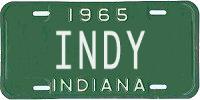"Let's check out the rest of what Indianapolis has to offer, shall we?"
INDIANA BLACK EXPO
Indiana Black Expo, Inc. (IBE) was founded in 1970 by a group of religious and civic leaders. In 1971, the same group created an exposition at the Indiana State Fairgrounds that showcased the achievements of African-Americans in the areas of culture, art, history, and economics. The first exposition was a major success, due to the collective efforts of a dedicated, all volunteer team of community workers. IBE continually upgraded the quality of programming at the exposition and, ultimately, the event outgrew the state fairgrounds. This growth inspired IBE to relocate the exposition to the Indiana Convention Center where the Summer Celebration flourished to become the largest and longest running exposition of its kind in the nation. Through many substantive workshops, IBE has played a vital role in addressing issues that reflect the needs and aspirations of African-Americans.
Today, Indiana Black Expo, Inc. has grown from a single annual event to a year-round, multifaceted community service organization.
SCOTTISH RITE CATHEDRAL
Highlights include a 7,500-pipe organ, a 54-bell carillon, a 200-light crystal chandelier, and intricate, handcrafted wood paneling. Interesting architecture is found all over Indianapolis! Here are "The Pyramids", located in the northwest area of Indianapolis. SLIPPERY NOODLE INN
The Slippery Noodle Inn, Indiana's oldest bar, and home of the Blues in Indiana has a rich history including a link to Union Station by many secret underground tunnels helping to form the Underground Railroad. The Noodle also features a full service menu serving until the wee hours of the morning. Wander through the recently historically renovated building and notice the original Tiger Oak bar in the front barroom with a smaller version oak bar duplicated in the back music room. The back inside wall was used for target practice and you can still see the bullets imbedded in the brick wall. The upstairs of the front building was originally built as a luxurious road house for railway passengers. Later years saw it used as a whore house with 23 small rooms. The Noodle is the oldest commercial building left standing in Indianapolis and the Tremont House sign painted on the north side of the building dates back to the 1850's. The Slippery Noodle is listed in the National Register of Historic Places.



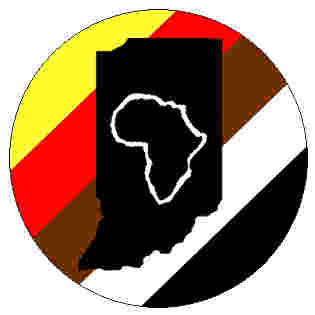

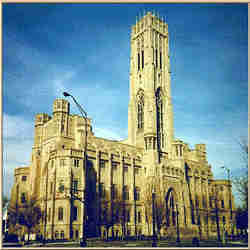 Declared "one of the seven most beautiful buildings in the world" by the International Association of Architects.
Declared "one of the seven most beautiful buildings in the world" by the International Association of Architects.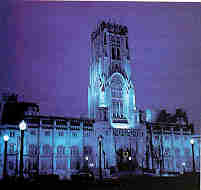 This Tudor gothic-style temple is the largest Scottish Rite cathedral in the world.
This Tudor gothic-style temple is the largest Scottish Rite cathedral in the world.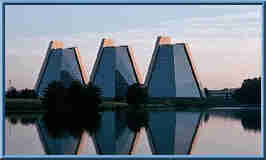

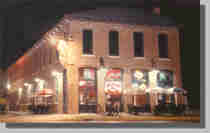 The Brady & Dillinger gang hung around at the tavern. The back music room used to be the livery stable.
The Brady & Dillinger gang hung around at the tavern. The back music room used to be the livery stable.
The present Union Station stands on the site of the first Union Station in the United States.
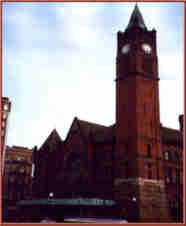
The first train pulled into Indianapolis on October 1, 1847 over the newly laid tracks from Madison, Indiana and started extensive changes in the town's economy as it quickly became one of the nation's rail centers.
Railroad leaders in Indianapolis saw the need for some kind of system to get growing numbers of trains and railroads in and out of town.
In August of 1849 the Union Railway Company was formed to solve the problem.
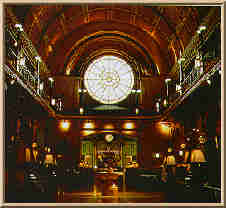 They laid track all the railroads could use on September 28,1853 they opened the first Union Station.
They laid track all the railroads could use on September 28,1853 they opened the first Union Station.
This building, a brick structure planned by Captain Thomas A. Morris, contained five tracks.
By the Civil War the station was already too small and was widened to 200 feet and an eating house was added.
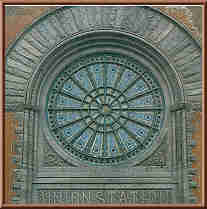 The necessity for a new, larger station was fulfilled in 1886 when the old station was demolished
The necessity for a new, larger station was fulfilled in 1886 when the old station was demolished
and the City Council granted several street closings to construct a new Union Station.
The Indianapolis Union Station represents an early example of planning for urban transportation.
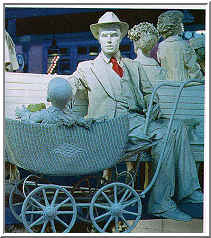 Built between 1886-1888, the new Union Station provides Indianapolis with one of the best examples of Romanesque Revival architecture in the United States.
Built between 1886-1888, the new Union Station provides Indianapolis with one of the best examples of Romanesque Revival architecture in the United States.
The rugged strength of Romanesque architecture has been carefully rendered here in materials, design, and space utilization.
During the peak of the railroad era,
200 trains a day moved through the station.
Union Station was placed on the National Register of Historic Places in 1974.

WALKER THEATER-C.J.WALKER
Madame Walker Urban Life Center was built as a tribute to America’s first self-made African-American female millionaire,
this four-story facility has been the focal point for Indianapolis’ African-American cultural scene.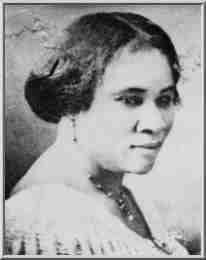
The Memorial Room contains a permanent exhibit highlights the life and work of Madame C.J. Walker.
She made her fortune by manufacturing hair care products for African-Americans.
The attached theater and ballroom which are embellished with African and Egyptian motifs
have housed performances by such greats as Louis Armstrong, Josephine Baker, and Lena Horne.
Known throughout the Midwest as a center for jazz in the 1920s,
the theater hosts plays, concerts, films, and "Jazz on the Avenue", which features local and regional talent every Friday night in the fourth-floor ballroom.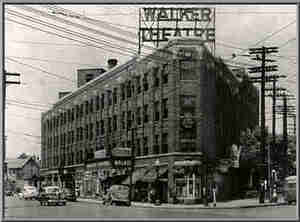
The Madame Walker Center along with Crispus Attucks Junior High School and Bethel A.M.E. Church are located in the Midtown/Crosstown neighborhood,
home to the first African-American settlers who came to Indianapolis in the early 1800s.
Built in 1927, Crispus Attucks was named for the first African-American to die in the U.S. Revolutionary War.
It is in the National Register of Historic Places.

PAN AM BUILDING
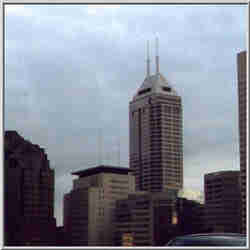 In the summer of 1987 4,453 athletes from 38 nations gathered in Indianapolis for the Pan American Games.
In the summer of 1987 4,453 athletes from 38 nations gathered in Indianapolis for the Pan American Games.
Located across from Union Station and the RCA Dome, Pan American Plaza was built to commemorate these Pan American Games.
Adorned with fountains and flags from participants’ countries, the plaza, complete with two Olympic-size indoor skating rinks, is used for outdoor events such as concerts and festivals.

INDIANAPOLIS CITY MARKET-FRESH VEGIES
Established in 1886, the original City Market is still standing and has never been out of business.
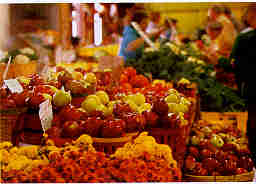 In 1974, the market was designated as a National Historic Landmark.
In 1974, the market was designated as a National Historic Landmark.
In an Old World atmosphere, the market's approximately 25 vendors offer fresh produce, meats, fish, baked goods, flowers, and imported foods and coffees.
Hand-crafted items from Indiana artisans are displayed in market carts during the week

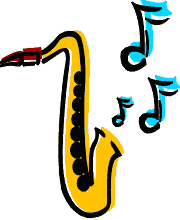

Featuring the best in jazz, blues, gospel, soul and much more, Indianapolis celebrates its storied jazz past with some of the biggest names in music and dozens of diverse Indianapolis artists.
The inaugural Indy Jazz Fest in 1999 attracted more than 65,000 attendees. Expected attendance in 2000 is 100,000 over the festival's five days. June 14-18, 2000

HOOK'S AMERICAN DRUGSTORE
Hook's Historic Drug Store and Pharmacy Museum is located at the Indiana State Fairgrounds.
This historic building features antique dental, medical, and pharmaceutical equipment, an antique soda fountain, and other drug store memorabilia.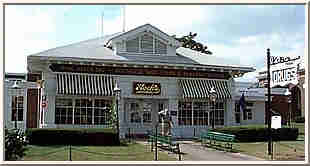
All the furnishings in the building came from Grigsby's Drug Store in the little Indiana town of Cambridge,
where they'd been in use from 1849 until 1962.
The museum opened its doors in 1966, established by the Hook's Drug Store chain to commemorate the Indiana Sesquicentennial.
Hook's stores were a common feature of the Indiana landscape for nearly a century.
At its height, the chain operated over 350 drug stores.
The museum's collection is a study in nostalgia.
The collection reflects the colorful history of the drug store all over America.
Cases are filled with once-common artifacts like curling iron heaters and and antique chewing gum wrappers.

INDIANA STATE FAIRGROUNDS
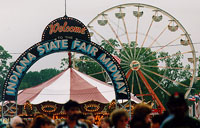 According to the International Association of Fairs and Expositions, the Indiana State Fair is the sixth oldest fair in the country; the first Indiana state fair was held in 1852.
According to the International Association of Fairs and Expositions, the Indiana State Fair is the sixth oldest fair in the country; the first Indiana state fair was held in 1852.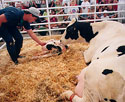
Although Indiana has one of the largest 4-H programs in the country, the Indiana State Fair is more than just bidding on champion livestock and looking at canned tomatoes.
Fairgoers can partake in traditional midway rides and fair food, and they can watch a giant balloon race, a professional motorcycle race, a rodeo, and harness racing, and see some of the nation's biggest country and western music artists.
and they can watch a giant balloon race, a professional motorcycle race, a rodeo, and harness racing, and see some of the nation's biggest country and western music artists.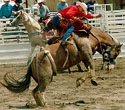
In addition to the Indiana State Fair, the Indiana State Fairgrounds hosts a variety of events almost every weekend of the year.
From art to antiques, guns to cars, sporting gear to home furnishings,the Fairgrounds attract two millions visitors a year to the shows in its buildings.

INDIANA REPERTORY THEATRE
Indiana's Repertory Theatre built in 1927, a one-time luxurious movie palace
features a terra cotta auditorium and facade based on 17th-century Spanish architecture.
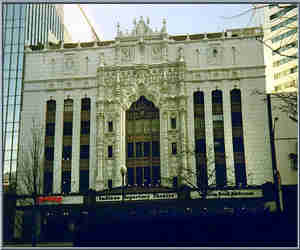
The historic gem was saved from the wrecking ball when the 3,000-seat theater was separated into three stages in 1984
to become the permanent home of the Indiana Repertory Theatre (IRT), a professional (Equity) resident theater.
Visitors can see the grand lobby; the mainstage, where the IRT performs its season of classic and contemporary works; the upperstage; and the cabaret theatre.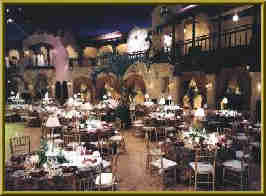
On display is a collection of costumes and theater props.
Housed in the same building, the Indiana Roof Ballroom is a beautifully restored ballroom designed to resemble the plaza of a Spanish village.
Under the 40-foot domed ceiling of stars and clouds, the Indiana Roof creates the illusion of snow, fog, bubbles, and a thunderstorm.

INTERNATIONALE BALLET
Under the artistic direction of former Kirov Ballet star Eldar Aliev,
Indiana’s only professional ballet company has quickly earned an international reputation for excellence.
Ballet Internationale now boasts a talented troupe of dancers
including former principals of the Bolshoi, Boston, Joffrey, New York City, and Moscow Classical Ballets;
an outstanding repertoire featuring the finest in classical and contemporary ballet; and the influence of the world’s finest designers, teachers, and artisans.
Ballet Internationale’s emergence as a force in the dance world began in January of 1995
when the company (then known as Indianapolis Ballet Theatre) appeared in a gala tribute honoring prima ballerina Irina Kolpakova.
Directed by Aliev and billed as "the gala of the decade," the event featured Ballet Internationale joined by guest stars from noted companies
including American Ballet Theatre, New York City Ballet, Boston Ballet, and Bolshoi Ballet.
The company also performs for more than 20,000 Indianapolis area students each year
as part of Dancing for the Future,
one of the nation’s most successful and longest-running outreach programs.

INDIANAPOLIS OPERA

Under the guidance of general director Nando Schellen, former artistic director of Amsterdam's Sweelinck Conservatory
and associate director of the Netherlands Opera,
Indianapolis Opera stages four productions each season at Clowes Memorial Hall,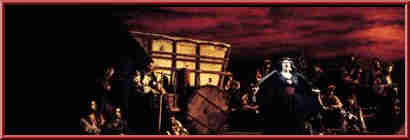
three with the Indianapolis Symphony Orchestra and one with the Indianapolis Chamber Orchestra.
Singers are selected through national auditions.
To ensure audience understanding, the company hosts pre-performance discussions of an opera's plot and characters.,
as well as of opera history in general.

MURAT SHRINE TEMPLE
Built in 1910, the Murat Theatre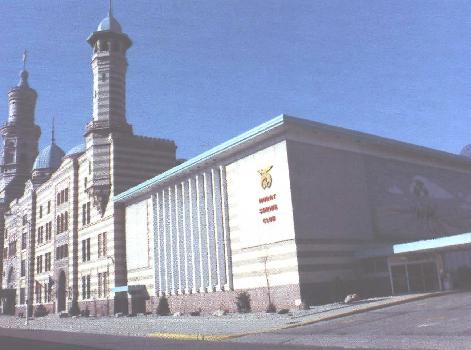 is the oldest surviving downtown stage;
is the oldest surviving downtown stage;
the Egyptian-influenced architecture provides an exotic counterpoint to the eclectic mix of performers who appear at the Murat.
Recently refurbished, the Murat now contains 2,681 seats,
making it the largest theater in Indianapolis.
Despite some of the alterations made during the refurbishing process, such as the removal of all balcony-level box seats,
it's still one of the most elegant live-performance venues around.

INDIANAPOLIS ARTS GARDEN
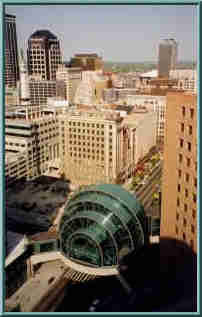 With a great view of our busy downtown Indianapolis, is the Indianapolis Artsgarden.
With a great view of our busy downtown Indianapolis, is the Indianapolis Artsgarden.
With it's relaxed atmosphere you can enjoy free arts exhibits and performances.
Built in 1995, the Artsgarden stands seventeen feet. It is located above the intersection of Washington and Illinois streets.
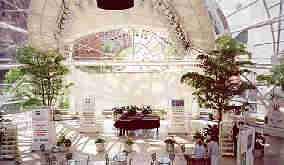
The Artsgarden connects the people of Indianapolis with the arts.
It’s owned and operated by the Arts Council of Indianapolis, and it’s the place you’ll find a wide variety of free arts performances and exhibitions all year long.
In fact, more than fifteen hundred artists perform and present their work here every year.

FORT HARRISON STATE PARK
Since 1903 Fort Harrison has played an important role in Indiana history.
 Although the Fort was slated for closure in 1991, reuse of the land will continue to serve the citizens of Indiana.
Although the Fort was slated for closure in 1991, reuse of the land will continue to serve the citizens of Indiana.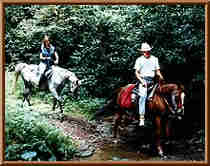
In 1995 the U.S. Department of the Interior approved the State of Indiana's request to convert 1,700 acres of the 2,500 acre post into a state park and nature preserve.
Fort Harrison State Park includes one of the largest tracts unbroken hardwood forest in Central Indiana, several small lakes, three and one-half miles of Fall Creek and its tributaries, trails, picnic areas and a huge heron rookery.
Now and in the years ahead, visitors will have the opportunity to enjoy recreation, education, and leisure activities within this beautiful area.
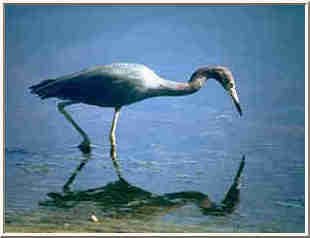
Facilities include:
Bicycle Trail, Cultural Arts Programs, Fishing, Hiking Trails / Multi-use Trail (paved), The Fort Golf Resort & Conference Center,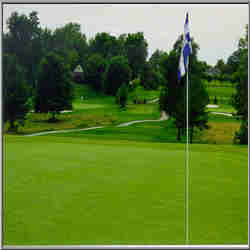
Harrison House Suites & 3 Officer's Homes.
The Garrison w/ Dining & Conference Facilities, Meeting Golf Course / 18 Holes & Driving Range,
Nature Center, Interpretive Services. Picnicking,
Picnic Shelters, Shelter Reservations,
Saddle Barn w/ Horse Trail Rides, Hayrides.



You will have a choice of hundreds of restaurants in Indianapolis...
Why not experience the Beef and Boards Dinner Theater?
For over 25 years, The Indianapolis Beef and Boards Dinner Theater has served up fun, food and fabulous live entertainment.
At Beef & Boards there is something for everyone.
Along with our professional Broadway Series Shows, we showcase some of the country's finest entertainers in our Monday Night Concert Series.
For those of you with children or grandchildren, don't miss our Live Theatre For Kids Shows.
When you come to Beef & Boards there's more to enjoy than great entertainment!
There's a lavish dinner buffet, featuring succulent carved roast beef, fish, chicken, vegetables and our bountiful salad bar.
Don't forget to save room for one of their gourmet desserts.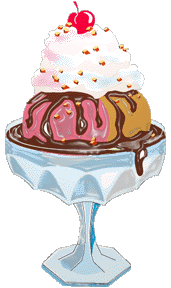
If your style is a bit more nostalgic...why not try...
Dick Clarks American Bandstand Grill!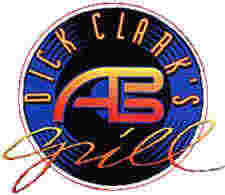
Dick Clarks features Classic American Cuisine, full bar
and great beer selection in a rock and roll memorabilia atmosphere.
in a rock and roll memorabilia atmosphere.
Dance Thursday - Saturday in the danceclub.
Shop for American Bandstand signature clothing and retail merchandise.
In the mood for a mystery....
Mystery Café started with this unique style of Dinner Theatre 10 years ago in Boston,
and since then they have entertained over a million people in 30 cities across the U.S.
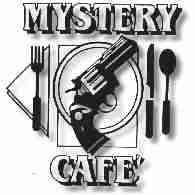 They are beginning their 7th year in Indianapolis.
They are beginning their 7th year in Indianapolis.
Each play unfolds in four acts with courses served after each act: soup, salad, entree, and dessert.
The audience participates in the mystery. Guests may participate as much, or as little, as they like.
When you arrive, you will be met at the door by a few of the evening's characters, who will help you find your seats and your new identity.
Fifteen to twenty guests are given lines to read at some point during the course of the play.
One group of guests is given a prepared song to sing.
When the first scene starts, keep a watchful eye open for clues, and jot down anything that looks suspicious.
At the end of the evening, a prize is given to the person who best solves the mystery.
A prize is also given to the biggest ham or that would be the best actor or actress from the audience.
Every performance is unique because the audience is so directly involved.
The real fun lies in the interaction and creativity which occur in a room full of people who began the evening as strangers, but go home as friends.

Don't miss...coming to Indianapolis Spring of 2001
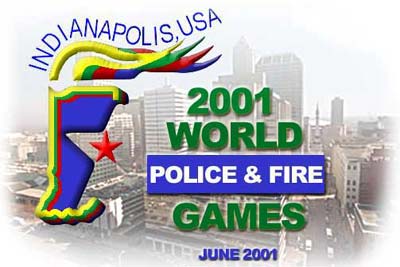
The "World Police and Fire Games"
Law Enforcement and Fire Department personnel from all over the world compete in this 9 day event for medals, much like the Olympic games.
The Indianapolis Games will offer over 70 different competitive sports for a total of more than 350 different events.


".....and did you know?"
Marcella Gruelle of Indianapolis created the Raggedy Ann doll in 1914.
 Indianapolis grocer Gilbert Van Camp discovered his customers enjoyed an old family recipe for pork and beans in tomato sauce.
Indianapolis grocer Gilbert Van Camp discovered his customers enjoyed an old family recipe for pork and beans in tomato sauce.He opened up a canning company and Van Camp's Pork and Beans became an American staple.
Before Indianapolis,
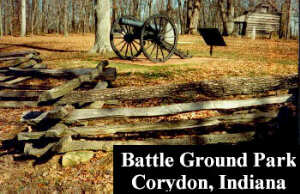 Corydon served as the state's capitol from 1816-1825. Vincennes was the capital when Indiana was a territory.
Corydon served as the state's capitol from 1816-1825. Vincennes was the capital when Indiana was a territory.In 1862, Richard Gatling, of Indianapolis,
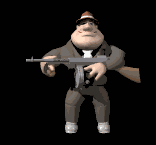 invented the rapid-fire machine gun.
invented the rapid-fire machine gun.The Indiana Gazette
 Indiana's first newspaper was published in Vincennes in 1804.
Indiana's first newspaper was published in Vincennes in 1804.The Saturday Evening Post
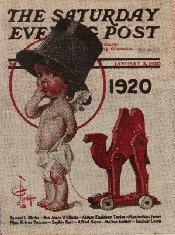 is published in Indianapolis.
is published in Indianapolis.![]()
"Ready for some B-ball!!! It's time to hang out downtown for a game or two!!"
![]()
PLEASE CLICK ON THE LICENSE PLATE BELOW TO BRING YOU TO PAGE FOUR OF THE TOUR!!
 "Back Home In Indiana"
"Back Home In Indiana"
